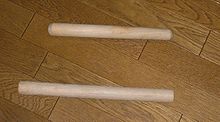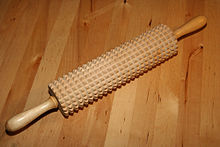- Rolling pin
-
A rolling pin is a cylindrical food preparation utensil used to shape and flatten dough. Two styles of rolling pins are found; roller and rods. Roller types consists of a thick cylindrical roller with small handles at each end; rod type rolling pins are usually thin tapered batons. Rolling pins of different styles and materials offer advantages over another, as they are used for different tasks in cooking and baking.
Contents
Types of rolling pins
- Rod: Thin rods typically made of wood around 2–3 cm in diameter. They are used by rolling the rod across the dough using one's palm. The pins may be tapered at one or both ends for more pivot control in certain tasks such as making small jiaozi skins or pie shells. Most East Asian or French style rolling pins, and the Turkish Oklava are rod style.
- Roller: Consists of a thick heavy roller made of a variety of materials around 7–10 cm in diameter with thinner handles which extend through the roller. They are used by grasping the handles and pushing the pin across the dough. Many Western rolling pins are roller types.
- Textured: Some specialized rolling pins have textured surfaces that mark and indents the dough surfaces for special breads and pancakes.
Textured rolling pin to flatten and perforate Northern European Crisp breads
 Striated rolling pin surface for making Norwegian Lefse
Striated rolling pin surface for making Norwegian Lefse
In South Asia, the rolling pin (belan) is used in combination with chakla (flat circular rolling board). The dough for chapatis is rolled on chakla with the help of the belan.[1] A modern electronic device called Roti Maker (or Tortilla maker) combines the function of chakla, belan and tava.
Material
Rolling pins come in a variety of sizes, shapes and materials including glass, ceramic, acrylic, bakelite, copper, brass, aluminium, silicone, wood, stainless steel, marble, and plastic.[2] Some are hollow and are able to be filled with cold or warm water to better roll a desired food. Marble rolling pins are often cooled in a refrigerator for maintaining a cold dough while making puff pastry.[3]
In popular culture
Rolling pins are the stereotypical weapon of angry housewives and are frequently employed in cartoons as an instrument for inflicting cranial injury. According to some cookbooks, heavy wooden roller type rolling pins are best used on kitchen helpers when frustrated, and not on dough.[4]
See also
References
Categories:- Cooking utensils
Wikimedia Foundation. 2010.



